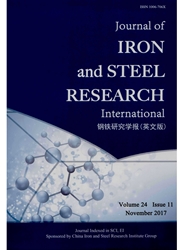

 中文摘要:
中文摘要:
The solidifi cation structures of alloy 800 H fabricated with and without linear electromagnetic stirring(L-EMS) were investigated. The results show that the solidification structure of the alloy can be obviously affected by the forced convection in melt caused by L-EMS. The average size of equiaxed grains of the alloy with L-EMS decreases from 3.5 mm to 2.3 mm, and the ratio of equiaxed grain increases from 5% to 43% compared with that without L-EMS. The microstructure of the alloy without L-EMS is composed of f ine equiaxed dendrites in the outermost layer and columnar dendrites in other areas, whereas that with L-EMS contains equiaxed dendrites, columnar dendrites and cross dendrites. In addition, the mechanism of dendrite fragment drift was proved by examining the composition change of the main alloying elements in the dendrite trunks at different solidifi cation stage using an electron probe micro-analyzer(EPMA).
 英文摘要:
英文摘要:
The solidification structures of alloy 800H fabricated with and without linear electromagnetic stirring (L-EMS) were investigated. The results show that the solidification structure of the alloy can be obviously affected by the forced convection in melt caused with L-EMS decreases from 3.5 mm to 2.3 mm, by L-EMS. The average size of equiaxed grains of the alloy and the ratio of equiaxed grain increases from 5% to 43% compared with that without L-EMS. The microstructure of the alloy without L-EMS is composed of fine equiaxed dendrites in the outermost layer and columnar dendrites in other areas, whereas that with L-EMS contains equiaxed dendrites, columnar dendrites and cross dendrites. In addition, the mechanism of dendrite fragment drift was proved by examining the composition change of the main alloying elements in the dendrite trunks at different solidification stage using an electron probe micro-analyzer (EPMA).
 同期刊论文项目
同期刊论文项目
 同项目期刊论文
同项目期刊论文
 Effect of electromagnetic stirring on fine grain formation and tensile property improvement for Fe-N
Effect of electromagnetic stirring on fine grain formation and tensile property improvement for Fe-N 期刊信息
期刊信息
